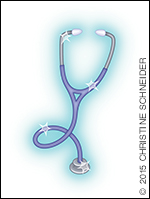
Fam Pract Manag. 2015;22(4):38
Keep your tools clean

Physicians regularly wash their hands to avoid cross-contaminating patients. But what about their tools?
A recent study1 found that the diaphragm of a stethoscope can carry a great deal of bacteria following a single patient examination, including antibiotic-resistant microorganisms.
For years, I have cleaned my stethoscope after washing my hands and before examining my patients. I use an alcohol swab, which is relatively cheap. I have been debating cleaning the stethoscope after seeing each patient, but it hasn't worked easily into my work flow.
I also have sought to avoid contamination when doing diabetic neuropathy exams, which usually involve a monofilament. Some physicians use the same monofilament for several patients, while others buy disposable monofilaments. I find that expensive, so we buy fishing line of the same weight as a monofilament, cut it up into the length of a monofilament, and throw away the fishing line after each use.2
Improve your time management
Our practice wanted to evaluate how we were managing time in the office. We went to the local discount store and bought some small digital clocks. We attached these to clipboards along with a time sheet from The Dartmouth Institute's Microsystem Academy (see page 17 of “Assessing, Diagnosing, and Treating Your Outpatient Primary Care Practice”). We handed the clipboards to patients, who used them to track how long various parts of their visits lasted. A staff member at the front desk who happens to love working with Excel spreadsheets assembled the data and put them into a graph.
We learned a lot. The first patients of the day were sitting in the lobby for 20 minutes while the staff was reviewing schedules, getting organized, and otherwise preparing for the day. We made getting patients into the exam room the first priority, and wait times dropped by two-thirds. We also found that our providers were consistently spending more time with patients than the schedule allowed. Consequently, we moved to a schedule that provided more time for visits. This actually improved finances because dealing with all of a patient's problems at the current visit instead of asking him or her to schedule another appointment allowed for more robust billing.
Avoid prescribing antibiotics for children's colds
The parents of young patients often demand – and get – antibiotics for their children's acute respiratory tract infections. Many of these prescriptions are unnecessary and contribute to increased bacterial resistance to antibiotics.
Physicians can try to avoid prescribing unwarranted antibiotics by using negative messages, such as telling parents why antibiotics aren't necessary or won't help. But this typically leads the parent to question the diagnosis, continue demanding antibiotics, and leave the visit frustrated.
A recent study of physicians who diagnosed viral infection in young patients found that using positive treatment messages, such as telling parents how to treat their child's symptoms, was linked with a 52 percent reduction in the risk of prescribing antibiotics for viral cases. Combining positive and negative messages decreased the risk even further (85 percent) and often led to higher parent satisfaction scores.
The researchers found that parents receiving recommendations for treating their child's symptoms saw this as similar to receiving a prescription, which reduced their frustration. They also noted that physicians who were uncertain whether a child's infection was viral or bacterial tended to have more success avoiding unnecessary antibiotics by providing parents with a contingency plan, such as recommending antibiotics if the child's condition failed to improve after a few days.
Editor's note: See “How to Help Your Patients Choose Wisely” for more on avoiding inappropriate care.
